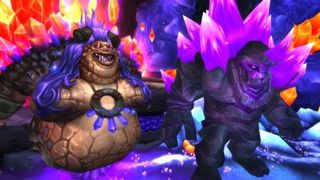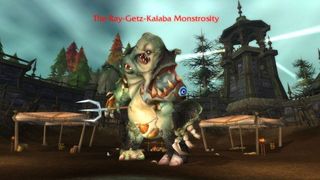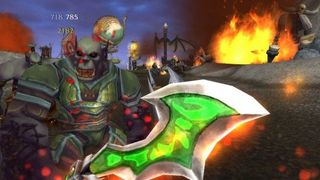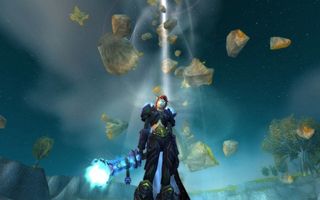Our Verdict
A triumph. Competitors beware: this is the best MMO in the world. Once you're hooked it's impossible to stop playing.
PC Gamer's got your back
It's big. Oh god, it's big.
World of Warcraft is the world's most successful subscription MMO. Orcs and humans, fighting dragons. It's four games welded into one vast whole: a multiplayer cooperative RPG in which you quest. A competitive fantasy team battleground game. A three-versus-three arena competitive ladder. And a 10- or 25-man dragon bashing cooperative raiding thing.
Together, those elements make for a deep and terrifyingly compulsive mix. The trouble was that to get anywhere in the latter three games, you had to go through the former.
80 levels of questing in WoW translates to around a month of fairly solid play. And pre-Cataclysm, that was a month of trawling through some of PC gaming's most mindnumbingly boring tasks. Ferrying packages across continents. Crawling through shit to find excreted seeds. Massacring leopards en route to killing more leopards.

Yes, Cataclysm is an extension of that. Five new levels taking the cap to 85, a bunch of new dungeons, extra professions, new races, blah blah. But it's also a rescue package. The story of Cataclysm – that of an angry dragon bursting out of the ground – is an excuse. An excuse to rebuild the world.
There were flashes of what WoW could be back in 2004: defending a robot monkey in the jungle. Tracking down crims in the back alleys of Stormwind. Getting a party together to kill a giant yeti. But it was mired in grind. WoW has an incredible sense of place, and you want to explore it. Its fantasy combat mechanics – a mix of spellcasting, avoiding damage and healing, while holding an enemy's attention with an armoured warrior/magic paladin/ angry bear – are fundamentally fun. Assassinating gnome mages in player versus player combat is hilarious. Defeating ancient guardians in abandoned temples in teams of 10 or 25 is brilliant. It's just a shame you had to play for a month to get there.
That's the point of Cataclysm: to deliver entertainment where there was filler between levels 1-60. Designers often talk about game interaction in terms of sentences. Actions are verbs, nouns are items. In old WoW, the only two verbs the engine could cope with were 'kill' or 'collect'. With the previous expansion pack, Wrath of the Lich King, WoW got a new verb: 'use'. It turns out, you can do a lot with that verb. Use 'explosives' on 'mammoth' to collect 'meat'. Use 'hot poker' on 'captive alliance prisoner' to get 'information'. Use 'robot suit' on 'harpy infested forest' to collect 'essential goblin supplies'. Use 'fireextinguisher' on 'burning forest' to 'save the orchard'.
Quests on speed
Quests introduced in Cataclysm are brisk, fun, and over in the blink of an eye. Quest hubs have five, maybe ten quests max, and can be burned through in ten minutes. Giant arrows on your map show you where to go. Any objects you need to collect are marked with a twinkle. Any monsters that need to die are highlighted with red text. Hover your cursor over them, and the game will tell you how many need to die, and why. The flow never stops moving you around, never lets up. And if the game ever does resort to asking you to kill ten of something – it's fine. Because it'll pair that objective with something to do along the way. Burn bales of hay, or rescue peons, or activate machines, or douse fires, or [verb] [noun].

At the back of your mind will be a nagging thought. “I'll just find this thing then go to bed,” or “let me finish this questline, and I'll do some work.” I've got some bad news. So expertly are you breadcrumbed around the world, teased with new objectives, that you're not going anywhere. Not for a month, at least.
You might think that WoW is for hardcore lore nerds, a kind of cartoon Lord of the Rings thing. Serious.Po-faced. It's really not. Blizzard aren't working with heavily controlled intellectual property like Warhammer, Star Trek, or Batman. They don't have to get their game and ideas approved. They're also pop-culture magpies. If they want to have spacefaring alien goats, they can. If they want to introduce vampires and werewolves, they can. What matters is the entertainment. Zones aren't places to explore: they're stories. Uldum is an Egyptian Indiana Jones movie with giant cat people. Gilneas is a Victorian era Twilight. Kezan is GTA: Goblin City. Westfall is CSI: Azeroth. Duskwood is a vampire story. Ashenvale is orcs versus elves in the woods.
In WoW today, entertainment trumps everything.

Redridge Mountains is a relatively low level zone. It's a valley surrounded by Orc camps, with one tiny Alliance village under constant threat in the far west. The story says the people of Redridge can't expect help from the vast Alliance armies of Stormwind. They're on their own. They need adventurers, stat.
But you're not good enough. What you really need to do is convince the local cage-fighter to help. He used to be in the special forces. He's in the backroom, fighting for kicks and cash. All his old mates have been captured or tortured. He's a ball of rage, with no outlet. He's Rambo.
Stage one: infiltrate the orc camps, put the fighter's team of five back together. Some are in cages. Others are strung up, hanging from cave walls. Stage two: gather the forces, and stake out a new camp. The mage turns himself into an rocket motor, and we zip across the shark infested lake. Stage three: we infiltrate. We cover ourselves in horse dung and plant satchel charges. Stage four: assassination – the leaders of the Orc camp are quietly released. Any further prisoners of war are set free. Stage five: detonation and escape: a gnome heli-drops a tank into the zone. Rambo jumps onto the gun, and proceeds to gib about a billion orcs. Stage six: the final showdown and heroic last stand with a very, very big, and very, very bad, boss.
Patchy
Cataclysm does have some dead patches. Often, the size of the old zones isn't compatible with WoW's new designs. New WoW puts the questgivers and monsters right next to each other. Old WoW would spread them about. New WoW favours tight, compact zones. Old WoW rambles. There's still too much flat open space in zones such as Durotar (Orc starting area) and the Barrens (the clue is in the name). And something has been lost with the new quest approach: one of the thrills of old WoW was exploring, discovering the world at your own pace. New WoW is a conveyor belt in which you input time, and output a level 85 Goblin mage.

But it's captivating. New players will think this is what all MMOs are like. The old players, once they've recovered from exploring the new, very top tier zones, will be thrilled with the changes.
Let's look at that top tier in detail.
The new zones are, mostly, very good. Uldum, mentioned earlier, is the standout: a comedy interpretation of Egyptian legend that plays out brilliantly. Deepholm is a vast underground cavern that seems to stretch on forever, and despite the claustrophobia, it's remarkably fun. Vash'jir, once you get over the fact you're underwater the entire time, is smart, although it seems to drag on. Being given a seahorse to swim around on helps. Twilight Highlands, the very last zone you enter, is ferociously story focused; it isn't as heavily themed as the other zones, but it does introduce you to a new Orc clan, and provide background to the baddie of the expansion: the dragon Deathwing.

Which leaves Mount Hyjal, which is a disappointment. The idea is that you're defending, and eventually repairing, a giant tree, on the site of the culminating battle of Warcraft III. It doesn't work, partly, I think, because you never get a sense of the location – you hop between caverns, portals, and points of interest too quickly to really stop and look around. Partly, the zone feels upside-down. The quest flow directs you down the mountain. Ascending for a final battle would make more narrative sense. Finally, the story isn't focused enough: it's got a giant turtle, a passable interpretation of the arcade game Joust, elementals, Twilight Council, this and that. Everything is thrown at you to hold interest, but nothing sticks, nor is there a memorable character. Compare that with the excellent questline in Twilight Highlands, which covers some of the same story beats, but does it with a funky new Orc War Lady-person.
The new dungeons are excellent. Dungeons have always been the place that first tests your class as you level, and the place to get the best loot. The new 80-85 dungeons, and their matching heroic (hard) modes are universally the best Blizzard have made. They're funny: it's hard not to laugh as you fight a squid that bounces from head to head, turning each player into an infected waterspewing tyrant. They're challenging: every class needs to use the full range of control abilities and interrupts – not just burn down the target as quickly as possible. And they're entertaining: nothing can quite match the thrill of riding into battle with a giant skeletal demon on the back of a camel.
Health and efficiency
The new dungeons also introduce WoW's new combat model – and it's a shock. The core concepts of WoW are relatively simple. Players do damage to monsters, and they fall over. Monsters do damage to players, and that damage must be avoided, or it must be healed. Over the last expansion packs to WoW, the damage output on all sides has rapidly increased, but the health pools of players haven't. That's sped the game up – and reduced the complexity. Healers play whack-amole with health bars, using their fastest spell to bring a target up to full health, while damage-dealing classes and tanks saw little reason to use their crowd control abilities to minimise the damage coming in. It was a heal or die, zero sum, game. You use flash heal, or your class's equivalent, or everyone died.

Now, health pools of players are vast. Consider a newly minted tank a level 80 (Wrath of the Lich King's level cap reached around 25,000/ 30,000 health points). That's following the health pool inflation of two expansion packs, and five years of patches and new gear. In Cataclysm, newly minted level 85 players have health pools of around 100,000 points. Damage is slower to occur, but the power of a healer's spells hasn't risen by the same factor of three, nor have their mana pools expanded to cope with more spells cast. The healing game now isn't whack-a-mole: it's triage. Healers are expected to pick their targets, and the spells they use, according to priority. Low cost heal-over-time spells for those who just need topping off. Big heals landing at the point of impact for tanks taking mega-hits. Flash heals for DPS classes that stand in fire or take unexpected damage. Group heals for panic stations. To help, all classes need to reduce the damage coming in – by being aware of their situation, interrupting abilities where possible, and by crowd controlling dangerous enemies in packs.
Smart groups of friends, playing over voice chat or with their guild, will be, and appear to be, fine. But for the random groups I've played in since Cataclysm launched, this new combat reality is taking time to sink in, and tempers are flaring. It's a better, more fun game for the change. But it's also a far harder game, and there's no easy ride. A dungeon-finder tool, introduced late in the Wrath of the Lich King expansion, makes finding a group easier, from a pool of players countrywide. But it doesn't automatically make players better, or better able to cope with the change from easy-mode care-bear questing to hard-mode face-palming.
Getting personal
Where the new combat model definitely improves WoW is in the player versus player modes, battlegrounds and arenas. Stretching combat out, rather than letting players gib each other in an instant, makes face-offs more interesting and more dynamic. There's more chance to save each other, more chance to fire off a cooldown or improvise an escape. The two new battlegrounds are very, very good: they're remixes of traditional capture the flag and capture-and-hold favourites, but the change of scenery is welcome. What doesn't work is the new open world combat zone: Tol Barad, a prison that can be captured by horde or alliance, for a chance to raid the bosses held within. Right now, it vastly favours the defenders, and rarely flips. It's a shame – open world PvP is when WoW feels most at war.

But it's still good. Good, and vast.
It was always obvious that I was going to enjoy Cataclysm: it's an extension of what I really like. What surprised me was just how much I enjoyed the new old world – perhaps more than levelling through the new stuff, and gearing for the raids to follow. Before, I used to warn people off them. Too much grind. Too boring. No one to play with. Now I recommend to my friends that they pick up WoW and try levelling a Goblin, or a Worgen (the two new races), just because it's such fun. Deathwing's ascent hasn't destroyed Azeroth: it's saved it from decline. In wreaking so much destruction, he's sowed the seeds of WoW's dominance of PC gaming for another six years.
A triumph. Competitors beware: this is the best MMO in the world. Once you're hooked it's impossible to stop playing.

